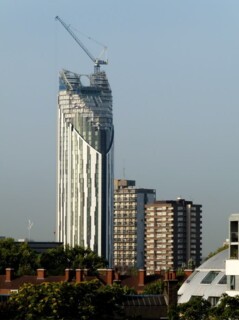White Elephant
Rosemary Hill on an Architectural Graveyard
The Elephant and Castle is an architectural graveyard over which a huge new tombstone is going up in the shape of the 43-storey Strata tower. Things began rather well in 1769, when Robert Mylne laid out the route south from his new bridge at Blackfriars and joined it to the old turnpike road with St George’s Circus. This was the first ‘circus’ in London, predating Piccadilly, the capital’s first roundabout. Since then almost every new idea in town planning – high-rise, low-rise, shopping precinct, pedestrian underpass and ever bigger roundabouts – has been imposed on the Elephant, with singular lack of success.
A website sponsored by Southwark Council and the LDA, tells the familiar lie that it was devastated during the Blitz and redevelopment was essential. In fact, in 1950 Pevsner found it still an ‘unself-conscious muddle of buildings and traffic’. Only in 1956 did the LCC implement its plan and clear the area. Out went houses and shops to make way for Ernö Goldfinger’s Alexander Fleming House and associated buildings including a cinema, the raised shopping centre, which failed from the beginning because it’s too difficult to get into, the banal London College of Printing, the terrifying underpasses and the giant silver egg box on the roundabout, properly known as the Michael Faraday Memorial. It’s an electricity substation designed by the late Rodney Gordon, Faraday’s house having been knocked down to make way for the new scheme. The only significant prewar survival is the remains of a building that really was bombed. In front of the rebuilt steel and glass chapel rises the mighty Corinthian portico of Spurgeon’s Tabernacle, built for a popular Baptist preacher in 1859-61 and still much used.
Soon seen to have been a failure, the postwar Elephant has been subject to successive tugs of war between developers, local authorities, residents and conservationists. Redevelopment plans have tended to light unerringly on what little is good and mark it out for destruction. The Twentieth Century Society helped save Alexander Fleming House but could not stop the demolition of Goldfinger’s attractive –and functioning – expressionist cinema. The University of the South Bank, housed in a cheap imitation of James Stirling’s Cambridge History Faculty, was with difficulty prevented by local people from demolishing the last quarter of St George’s Circus and its adjacent 1820s houses.
Strata is part of the latest regeneration plan, which is going ahead in fits and starts. Of the 310 private flats in the building all but four were pre-sold in 2007. How many of those ‘buyers’ paid more than a minimal deposit and how many will still be able to get mortgages at the agreed price is not known. The remaining four ‘penthouse apartments’ are on the market from £850,000 to over £1m. They are not being snapped up. Strata is described by the developers, Brookfield Europe, as ‘a bold and visionary statement’. In fact it is ugly and undistinguished, except by its size. It’s the tallest building in SE1, Brookfield claims, or will be until Renzo Piano’s Shard at London Bridge is finished. The Shard is scheduled for completion in May 2012 so after little more than two years, Strata will lose its only claim to distinction and join the list of bad planning ideas that came to the Elephant to die.
